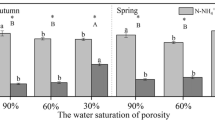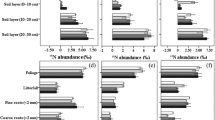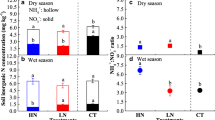Abstract
In Mediterranean-type ecosystems, nitrogen (N) accumulates in soil during dry summer months and rapidly becomes available during early season rain events. The availability of early season N could depend on the size of rainfall events, soil microbial activity, and phenology of the plant community. However, it is poorly understood how precipitation patterns affect the fate of early season N. Microbes and plants with early phenology may compete strongly for early season N but theory suggests that microbial N storage can meet plant N demands later in the season. Using a 15N tracer and rainfall manipulation we investigated the fate of early season N. N allocation patterns differed substantially between microbes, early and late phenology plants. As expected early phenology annuals and microbes took up 15N, within 1 day, whereas a late-phenology shrub allocated 15N to leaves later in the season. We saw no evidence for microbial storage of early season N; the peak of 15N in shrub leaves did not coincide with detectable levels of 15N in the microbial biomass or labile soil pool. This suggests that shrubs were able to access early season N, store and allocate it for growth later in the season. Although we saw no evidence of microbial N storage, N retention in soil organic matter (SOM) was high and microbes may play an important role in sequestering N to SOM. Plant N uptake did not respond significantly to 1 year of rainfall manipulation, but microbes were sensitive to dry conditions. 1 year after 15N addition shrubs had resorbed up to half of the N from leaves whereas N in annuals remained as dead leaf litter. Differences in end-of-season N partitioning between dead and living biomass in the two vegetation types suggest that plant species composition could affect N availability in the following growing season, but it may take several years of altered precipitation patterns to produce rainfall-dependent changes.






Similar content being viewed by others
References
Aerts R, Chapin FS. 2000. The mineral nutrition of wild plants revisited: a re-evaluation of processes and patterns. Waltham: Academic Press.
Agnelli A, Celi L, Degl’Innocenti A, Corti G, Ugolini FC. 2000. Chemical and spectroscopic characterization of the humic substances from sandstone-derived rock fragments. Soil Sci 165:314–27.
Austin AT, Vivanco L. 2006. Plant litter decomposition in a semi-arid ecosystem controlled by photodegradation. Nature 442:555–8.
Austin AT, Yahdjian L, Stark JM, Belnap J, Porporato A, Norton U, Ravetta DA, Schaeffer SM. 2004. Water pulses and biogeochemical cycles in arid and semiarid ecosystems. Oecologia 141:221–35.
Bartlett RJ, Ross DS. 1988. Colorimetric determination of oxidizable carbon in acid soil solutions. Soil Sci Soc Am J 52:1191–2.
Bell CW, Acosta-Martinez V, McIntyre NE, Cox S, Tissue DT, Zak JC. 2009. Linking microbial community structure and function to seasonal differences in soil moisture and temperature in a Chihuahuan desert grassland. Microb Ecol 58:827–42.
Birch HF. 1958. The effect of soil drying on humus decomposition and nitrogen availability. Plant Soil 10:9–31.
Borken W, Matzner E. 2009. Reappraisal of drying and wetting effects on C and N mineralization and fluxes in soils. Glob Change Biol 15:808–24.
Brookes PC, Landman A, Pruden G, Jenkinson DS. 1985. Chloroform fumigation and the release of soil-nitrogen: a rapid direct extraction method to measure microbial biomass nitrogen in soil. Soil Biol Biochem 17:837–42.
Cayan DR, Maurer EP, Dettinger MD, Tyree M, Hayhoe K. 2008. Climate change scenarios for the California region. Clim Change 87:S21–42.
Cerda A. 1998. Soil aggregate stability under different Mediterranean vegetation types. Catena 32:73–86.
Chen RR, Dittert K. 2008. Diffusion technique for N-15 and inorganic N analysis of low-N aqueous solutions and Kjeldahl digests. Rapid Commun Mass Spectrom 22:1727–34.
Cleveland CC, Liptzin D. 2007. C:N:P stoichiometry in soil: is there a “Redfield ratio” for the microbial biomass? Biogeochemistry 85:235–52.
Collins SL, Sinsabaugh RL, Crenshaw C, Green L, Porras-Alfaro A, Stursova M, Zeglin LH. 2008. Pulse dynamics and microbial processes in aridland ecosystems. J Ecol 96:413–20.
Davidson EA, Hart SC, Shanks CA, Firestone MK. 1991. Measuring gross nitrogen mineralization, immobilization, and nitrification by N-15 isotopic pool dilution in intact soil cores. J Soil Sci 42:335–49.
Davidson EA, Matson PA, Vitousek PM, Riley R, Dunkin K, Garciamendez G, Maass JM. 1993. Processes regulating soil emissions of NO and N2O in a seasonally dry tropical forest. Ecology 74:130–9.
Diffenbaugh NS, Giorgi F, Pal JS. 2008. Climate change hotspots in the United States. Geophys Res Lett 35:5.
Dijkstra FA, Augustine DJ, Brewer P, von Fischer JC. 2012. Nitrogen cycling and water pulses in semiarid grasslands: are microbial and plant processes temporally asynchronous? Oecologia 170:799–808.
Donders ART, van der Heijden G, Stijnen T, Moons KGM. 2006. Review: a gentle introduction to imputation of missing values. J Clin Epidemiol 59:1087–91.
Easterling DR, Meehl GA, Parmesan C, Changnon SA, Karl TR, Mearns LO. 2000. Climate extremes: observations, modeling, and impacts. Science 289:2068–74.
Eviner VT, Firestone MK. 2007. Mechanisms determining patterns of nutrient dynamics. In: Stromberg MR, Corbin JD, D’Antonio CM, Eds. California grasslands: ecology and management. California: University of California Press. p 94–106.
Fay PA, Carlisle JD, Danner BT, Lett MS, McCarron JK, Stewart C, Knapp AK, Blair JM, Collins SL. 2002. Altered rainfall patterns, gas exchange, and growth in grasses and forbs. Int J Plant Sci 163:549–57.
Fenn ME, Baron JS, Allen EB, Rueth HM, Nydick KR, Geiser L, Bowman WD, Sickman JO, Meixner T, Johnson DW, Neitlich P. 2003. Ecological effects of nitrogen deposition in the western United States. Bioscience 53:404–20.
Fierer N, Schimel JP. 2002. Effects of drying–rewetting frequency on soil carbon and nitrogen transformations. Soil Biol Biochem 34:777–87.
Foereid B, Bellarby J, Meier-Augenstein W, Kemp H. 2010. Does light exposure make plant litter more degradable? Plant Soil 333:275–85.
Golluscio RA, Sala OE, Lauenroth WK. 1998. Differential use of large summer rainfall events by shrubs and grasses: a manipulative experiment in the Patagonian steppe. Oecologia 115:17–25.
Gray JT, Schlesinger WH. 1983. Nutrient use by evergreen and deciduous shrubs in Southern-California. 2. Experimental investigations of the relationship between growth, nitrogen uptake and nitrogen availability. J Ecol 71:43–56.
Groffman PM, Tiedje JM. 1988. Denitrification hysteresis during wetting and drying cycles in soil. Soil Sci Soc Am J 52:1626–9.
Hagedorn F, Schleppi P. 2000. Determination of total dissolved nitrogen by persulfate oxidation. J Plant Nutr Soil Sci 163:81–2.
Hart SC, Firestone MK, Paul EA, Smith JL. 1993. Flow and fate of soil-nitrogen in an annual grassland and a young mixed-conifer forest. Soil Biol Biochem 25:431–42.
Heisler JL, Weltzin JF. 2006. Variability matters: towards a perspective on the influence of precipitation on terrestrial ecosystems. New Phytol 172:189–92.
Holmes TH, Rice KJ. 1996. Patterns of growth and soil-water utilization in some exotic annuals and native perennial bunchgrasses of California. Ann Bot 78:233–43.
Hooker TD, Stark JM. 2008. Soil C and N cycling in three semiarid vegetation types: response to an in situ pulse of plant detritus. Soil Biol Biochem 40:2678–85.
Hooker TD, Stark JM. 2012. Carbon flow from plant detritus and soil organic matter to microbes-linking carbon and nitrogen cycling in semiarid soils. Soil Sci Soc Am J 76:903–14.
Huxman TE, Snyder KA, Tissue D, Leffler AJ, Ogle K, Pockman WT, Sandquist DR, Potts DL, Schwinning S. 2004. Precipitation pulses and carbon fluxes in semiarid and arid ecosystems. Oecologia 141:254–68.
Ivans CY, Leffler AJ, Spaulding U, Stark JM, Ryel RJ, Caldwell MM. 2003. Root responses and nitrogen acquisition by Artemisia tridentata and Agropyron desertorum following small summer rainfall events. Oecologia 134:317–24.
Jackson LE, Schimel JP, Firestone MK. 1989. Short-term partitioning of ammonium and nitrate between plants and microbes in an annual grassland. Soil Biol Biochem 21:409–15.
Jackson LE, Strauss RB, Firestone MK, Bartolome JW. 1988. Plant and soil-nitrogen dynamics in California annual grassland. Plant Soil 110:9–17.
James JJ, Aanderud ZT, Richards JH. 2006. Seasonal timing of N pulses influences N capture in a saltbush scrub community. J Arid Environ 67:688–700.
James JJ, Davies KW, Sheley RL, Aanderud ZT. 2008. Linking nitrogen partitioning and species abundance to invasion resistance in the Great Basin. Oecologia 156:637–48.
James S. 1984. Lignotubers and burls: their structure, function and ecological significance in Mediterranean ecosystems. Bot Rev 50:225–66.
Kaye JP, Hart SC. 1997. Competition for nitrogen between plants and soil microorganisms. Trends Ecol Evol 12:139–43.
Kummerow J, Krause D, Jow W. 1977. Root systems of chaparral shrubs. Oecologia 29:163–77.
Kummerow J, Krause D, Jow W. 1978. Seasonal changes of fine root density in southern California chaparral. Oecologia 37:201–12.
Lipson DA, Bowman WD, Monson RK. 1996. Luxury uptake and storage of nitrogen in the rhizomatous alpine herb, Bistorta bistortoides. Ecology 77:1277–85.
Lipson DA, Schmidt SK, Monson RK. 1999. Links between microbial population dynamics and nitrogen availability in an alpine ecosystem. Ecology 80:1623–31.
Luo HY, Oechel WC, Hastings SJ, Zulueta R, Qian YH, Kwon H. 2007. Mature semiarid chaparral ecosystems can be a significant sink for atmospheric carbon dioxide. Glob Change Biol 13:386–96.
Ma SY, Baldocchi DD, Hatala JA, Detto M, Yuste JC. 2012. Are rain-induced ecosystem respiration pulses enhanced by legacies of antecedent photodegradation in semi-arid environments? Agric For Meteorol 154:203–13.
Meehl GA, Stocker TF, Collins WD, Friedlingstein P, Gaye AT, Gregory JM, Kitoh A, Knutti R, Murphy JM, Noda A, Raper SCB, Watterson IG, Weaver AJ, Zhao Z.-C. 2007. Global climate projections, Cambridge, UK and New York, USA.
Meixner FX, Yang WX. 2006. Biogenic emissions of nitric oxide and nitrous oxide from arid and semi-arid land. Dryland Ecohydrol:233–55.
Meixner T, Fenn M. 2004. Biogeochemical budgets in a Mediterranean catchment with high rates of atmospheric N deposition: importance of scale and temporal asynchrony. Biogeochemistry 70:331–56.
Millard P, Grelet GA. 2010. Nitrogen storage and remobilization by trees: ecophysiological relevance in a changing world. Tree Physiol 30:1083–95.
Miller AE, Schimel JP, Meixner T, Sickman JO, Melack JM. 2005. Episodic rewetting enhances carbon and nitrogen release from chaparral soils. Soil Biol Biochem 37:2195–204.
Mooney HA, Rundel PW. 1979. Nutrient relations of the evergreen shrub, Adenostoma fasciculatum, in the California chaparral. Bot Gaz 140:109–13.
Moreno JM, Oechel WC. 1991. Fire intensity effects on germination of shrubs and herbs in southern California chaparral. Ecology 72:1993–2004.
Navarro-Garcia F, Casermeiro MA, Schimel JP. 2012. When structure means conservation: effect of aggregate structure in controlling microbial responses to rewetting events. Soil Biol Biochem 44:1–8.
Norton JB, Monaco TA, Norton U. 2007. Mediterranean annual grasses in western North America: kids in a candy store. Plant Soil 298:1–5.
Noy-Meir I. 1973. Desert ecosystems, environment and producers. Annu Rev Ecol Syst 4:25–51.
Oesterheld M, Loreti J, Semmartin M, Sala OE. 2001. Inter-annual variation in primary production of a semi-arid grassland related to previous-year production. J Veg Sci 12:137–42.
Ogle K, Reynolds JF. 2004. Plant responses to precipitation in desert ecosystems: integrating functional types, pulses, thresholds, and delays. Oecologia 141:282–94.
Parker SS, Schimel JP. 2010. Invasive grasses increase nitrogen availability in California grassland soils. Invasive Plant Sci Manag 3:40–7.
Parker SS, Schimel JP. 2011. Soil nitrogen availability and transformations differ between the summer and the growing season in a California grassland. Appl Soil Ecol 48:185–92.
Pierce DW, Das T, Cayan DR, Maurer EP, Miller NL, Bao Y, Kanamitsu M, Yoshimura K, Snyder MA, Sloan LC, Franco G, Tyree M. 2013. Probabilistic estimates of future changes in California temperature and precipitation using statistical and dynamical downscaling. Clim Dyn 40:839–56.
Pitt MD, Heady HF. 1978. Responses of annual vegetation to temperature and rainfall patterns in Northern California. Ecology 59:336–50.
Pugnaire FI, Chapin FS. 1993. Controls over nutrient resorption from leaves of evergreen Mediterranean species. Ecology 74:124–9.
Quinn GP, Keough MJ. 2002. Experimental design and data analysis for biologists. Cambridge: Cambridge University Press.
Saetre P, Stark JM. 2005. Microbial dynamics and carbon and nitrogen cycling following re-wetting of soils beneath two semi-arid plant species. Oecologia 142:247–60.
Sala OE, Gherardi LA, Reichmann L, Jobbagy E, Peters D. 2012. Legacies of precipitation fluctuations on primary production: theory and data synthesis. Philos Trans R Soc B 367:3135–44.
Sala OE, Lauenroth WK. 1982. Small rainfall events: an ecological role in semi-arid regions. Oecologia 53:301–4.
Sala OE, Lauenroth WK, Parton WJ. 1992. Long-term soil-water dynamics in the shortgrass steppe. Ecology 73:1175–81.
Schimel JP, Jackson LE, Firestone MK. 1989. Spatial and temporal effects on plant microbial competition for inorganic nitrogen in a California annual grassland. Soil Biol Biochem 21:1059–66.
Schwinning S, Sala OE. 2004. Hierarchy of responses to resource pulses in and semi-arid ecosystems. Oecologia 141:211–20.
Singh JS, Raghubanshi AS, Singh RS, Srivastava SC. 1989. Microbial biomass acts as a source of nutrients in dry tropical forest and Savanna. Nature 338:499–500.
Snyder KA, Donovan LA, James JJ, Tiller RL, Richards JH. 2004. Extensive summer water pulses do not necessarily lead to canopy growth of Great Basin and northern Mojave Desert shrubs. Oecologia 141:325–34.
Stark JM, Firestone MK. 1995. Mechanisms for soil moisture effects on activity of nitrifying bacteria. Appl Environ Microbiol 61:218–21.
Stark JM, Hart SC. 1996. Diffusion technique for preparing salt solutions, Kjeldahl digests, and persulfate digests for nitrogen-15 analysis. Soil Sci Soc Am J 60:1846–55.
Templer PH, Mack MC, Chapin FS, Christenson LM, Compton JE, Crook HD, Currie WS, Curtis CJ, Dail DB, D’Antonio CM, Emmett BA, Epstein HE, Goodale CL, Gundersen P, Hobbie SE, Holland K, Hooper DU, Hungate BA, Lamontagne S, Nadelhoffer KJ, Osenberg CW, Perakis SS, Schleppi P, Schimel J, Schmidt IK, Sommerkorn M, Spoelstra J, Tietema A, Wessel WW, Zak DR. 2012. Sinks for nitrogen inputs in terrestrial ecosystems: a meta-analysis of N-15 tracer field studies. Ecology 93:1816–29.
von Lutzow M, Kogel-Knabner I, Ekschmitt K, Matzner E, Guggenberger G, Marschner B, Flessa H. 2006. Stabilization of organic matter in temperate soils: mechanisms and their relevance under different soil conditions: a review. Eur J Soil Sci 57:426–45.
Vourlitis GL, Fernandez JS. 2012. Changes in the soil, litter, and vegetation nitrogen and carbon concentrations of semiarid shrublands in response to chronic dry season nitrogen input. J Arid Environ 82:115–22.
Waldrop MP, Firestone MK. 2006. Seasonal dynamics of microbial community composition and function in oak canopy and open grassland soils. Microb Ecol 52:470–9.
Weltzin JF, Loik ME, Schwinning S, Williams DG, Fay PA, Haddad BM, Harte J, Huxman TE, Knapp AK, Lin GH, Pockman WT, Shaw MR, Small EE, Smith MD, Smith SD, Tissue DT, Zak JC. 2003. Assessing the response of terrestrial ecosystems to potential changes in precipitation. Bioscience 53:941–52.
Wolkovich EM, Lipson DA, Virginia RA, Cottingham KL, Bolger DT. 2010. Grass invasion causes rapid increases in ecosystem carbon and nitrogen storage in a semiarid shrubland. Glob Change Biol 16:1351–65.
Yahdjian L, Sala OE. 2010. Size of precipitation pulses controls nitrogen transformation and losses in an arid Patagonian ecosystem. Ecosystems 13:575–85.
Zak DR, Groffman PM, Pregitzer KS, Christensen S, Tiedje JM. 1990. The vernal dam: plant microbe competition for nitrogen in northern hardwood forests. Ecology 71:651–6.
Acknowledgments
Many thanks to Angie Ashbacher and Chris Kopp, with whom I had fun constructing rainfall shelters and irrigation systems. Thanks also to the undergraduate research assistants Janelle Durer, Brittany Carlson, and Tina Trieu for many dedicated hours in the lab. And to Cove Sturtevant, Jaime Zlamal, Hiroki Ikawa, and Tom Bell for field assistance. This work was supported by NSF grant DEB (1154082).
Author information
Authors and Affiliations
Corresponding author
Additional information
Author Contributions
M. Mauritz: experimental design, data analysis and collection, manuscript writing; E. Cleland: design, analysis, manuscript revision; M. Merkley: data collection and analysis; D. A. Lipson: design, analysis, manuscript revision.
Rights and permissions
About this article
Cite this article
Mauritz, M., Cleland, E., Merkley, M. et al. The Influence of Altered Rainfall Regimes on Early Season N Partitioning Among Early Phenology Annual Plants, a Late Phenology Shrub, and Microbes in a Semi-arid Ecosystem. Ecosystems 17, 1354–1370 (2014). https://doi.org/10.1007/s10021-014-9800-6
Received:
Accepted:
Published:
Issue Date:
DOI: https://doi.org/10.1007/s10021-014-9800-6




